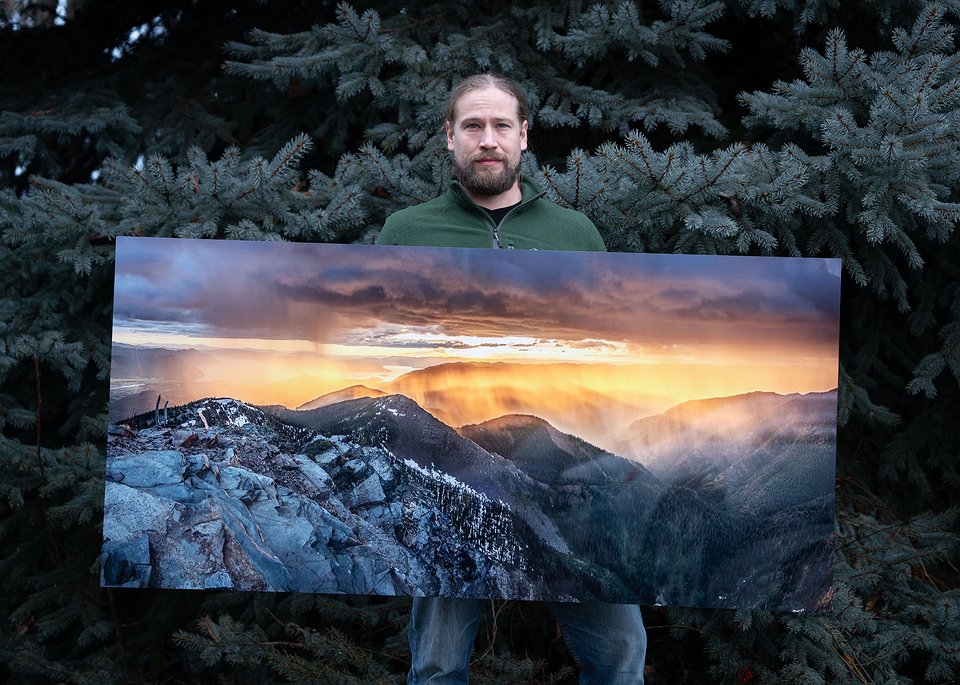Shooting something special — 'Pucktography' pursues rare moments
PONDERAY — Ever snap a photo of a critter in the woods or an especially vivid sunset? Ponderay’s Brandon Puckett does that, too — but takes it to the next level.
Puckett, an adventure photographer, travels the western U.S. and Canadian Rockies to capture images of mountains, water, wildlife and people and share them with his audience on his popular “Pucktography” Facebook page.
He specializes in capturing “what is rarely seen”: a remote peak at twilight, an eagle grasping a fish in its talons, or a sea of yellow tamaracks during their narrow fall foliage window.
“I don’t want to feel like I’m missing out,” he explained.
Puckett’s path to adventure photography started before he could walk, when his grandmother carried him in a baby backpack through the woods near his hometown of Libby, Montana.
He went on to discover a love of hiking and backpacking. Once he was old enough to drive, he began taking solo trips to the mountains and shooting photos of the sights he saw.
“When I went out alone, the only way I knew how to share it was through pictures,” Puckett said.
To support himself after high school, Puckett acquired a commercial driver's license and hauled water across North Dakota’s oil fields, often working long shifts throughout the day and night.
He quit the job in 2017, and using the money he’d saved, moved back to the Inland Northwest and began pursuing his photography dream.
Today, Puckett splits time traveling for photography, shooting in the wilderness close to home, hosting workshops for aspiring photographers and selling photos and prints on his website and at Art Works Gallery in downtown Sandpoint.
When he’s choosing what to capture, his focus shifts depending on his location and the conditions around him. Last year, a collection of factors gave him a unique target — auroras in the night sky.
An aurora (or the northern lights) is the visible reaction that occurs when the sun ejects energy and particles into Earth’s atmosphere during a solar storm.
2024’s solar storms were as frequent and powerful as they’ve been in decades, resulting in vibrant auroras across the continent throughout the year.
One September evening, Puckett trekked into the Selkirk Mountains to try to get a shot of the northern lights. After staying up all night without seeing a hint of an activity, Puckett hiked down at sunrise, drove back to town, and slept until noon.
When he woke up, a friend told him that forecasters were predicting the lights would be out that night. Puckett skipped his evening jiu-jitsu class and headed back to the trailhead he’d just left that morning. As he hiked up under an empty sky, a gut feeling told him to keep faith that an aurora would come.
When he gained a ridge above Harrison Lake around midnight, the lights finally came — green ribbons rippling and pulsing directly over Harrison Peak. Puckett shot the phenomenon all night, capturing panoramic photos of the sky above and the moonlit terrain below.
“People think the full moon deters from the lights,” Puckett said. “It actually allowed me to capture the landscape.”
As the sun rose and the aurora faded, Puckett found himself praying on the ridge. His faith, he said, is at the center of his art; he often feels close to God in North Idaho’s wilderness.
“Me and God go places,” Puckett said. “Even when I’m alone, I’m not fully alone.”
Sometimes, Puckett catches a stroke of luck and has a chance to capture multiple rare phenomena at once. In October 2024, he received a tip from a friend that the Milky Way Galaxy and the comet Tsuchinshan–ATLAS — which only visits the solar system once every 80,000 years — would line up over Lake Pend Oreille if photographed from the east shore.
Puckett loaded his kayak into his Subaru at dusk, parked off Highway 200 and paddled to a remote area. There, he planned to capture the cosmos along with a petroglyph panel on a cliff face near the water believed to have been created by Native Americans.
When Puckett was ready to shoot, clouds obscured the sky and gusts of wind continually blew out the candles he had brought to illuminate the petroglyphs. When the clouds parted for a moment, he turned on his camera’s self-timer feature, ran down to the base of the cliff out of frame, and using the nylon fabric of a dry bag to soften the beam, waved a flashlight around to light the face while his camera took a long-exposure photo.
The end result? A snapshot of engravings resembling bear paws on a lichen-coated stone wall beneath a white-tailed comet and the purple-blue haze of the Milky Way’s many distant stars.
“That was my favorite photo of 2024,” said Puckett. “It’s something no one else has.”
A similar image, Puckett said, could be created by snapping two or more photos at separate times and stitching them together with software later.
To him, though, the result wouldn’t be the same. Puckett originally picked up a camera to share his wilderness experiences with friends and family. Today, he holds true to that intent by capturing only what he sees with his own two eyes.
“It’s a real moment in time,” Puckett said of his petroglyph photo.
“Otherwise, how would I tell a story?” he added. “Without a story, it’s just a pretty picture.”



